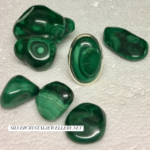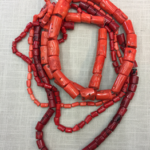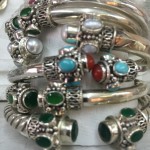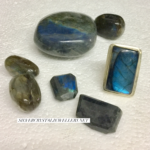Quartz is the most common mineral on the face of the Earth. Chemically, quartz is a compound called silicon dioxide, SiO2. As a crystal, quartz is used as a semiprecious gemstone. Quartz is a relatively hard stone, 7 on the Mohs hardness scale.
 Quartz is one of the most abundant mineral crystals and can take many forms. Quartz is a piezoelectric material that moves when placed in an electric field. It has been applied in various devices as an oscillator.
Quartz is one of the most abundant mineral crystals and can take many forms. Quartz is a piezoelectric material that moves when placed in an electric field. It has been applied in various devices as an oscillator.
Quartz is used extensively in industry and was used in radios and most of all it had its impact in the watch industry. It is very resistant to chemical weathering. A conchoidal fracture will result when quartz is struck and it has no cleavage.
In pure form, quartz is colorless, but it is commonly colored by impurities. Rose quartz is a pink stone often worn as crystal pendants or bead necklaces.
Green quartz is sometimes referred to as aventurine quartz. Milky quartz is a common mineral that is found in many different types of rocks. Pink or peach colored quartz is called rose quartz. Smoky quartz is generally transparent to translucent quartz that is gray to black in color. The most common and familiar inclusion in quartz is rutile. Rutilated Quartz is a variety of Quartz crystal that contains small needles of Rutile trapped inside.
Amethyst is the purple variety of quartz and is a popular gemstone. Amethyst is the most highly valued stone in the quartz group. Amethyst displays shades of violet due to the presence of small amounts of Fe3+ ions. Amethyst is sometimes heat treated to form citrine. On exposure to heat, amethyst generally becomes yellow, and much of the cairngorm or yellow quartz of jewelry is said to be merely ‘burnt amethyst.
Ametrine occurs naturally and is the combination of amethyst and citrine in the same crystal. Ametrine is a variety of quartz that contains both amethyst and citrine sectors in the same crystal. Ametrine is a real gemstone variety mostly found in Bolivia. Ametrine is a very durable gemstone suited for everyday wear. Ametrine, Quartz, Natural ametrine is not usually enhanced; amethyst can be heated to produce ametrine.
Citrine is a macrocrystalline variety of the mineral Quartz (SiO2). Sometimes you will hear citrine referred to as topaz quartz, which is incorrect. Citrine includes yellow to gold to orange brown shades of transparent quartz. Citrine crystals can form together with amethyst or smoky quartz to form ametrine and bi-colored quartz. Most commercial citrine is in fact artificially heated amethyst or smoky quartz.
Citrine crystals can form together with amethyst to form ametrine, or with smoky quartz to form bicolored quartz. One of the most durable gemstones, citrine gets its name from the French for lemon, in honor of its vibrant yellow hue. The difference between citrine and amethyst is only the Oxidation State of the iron impurities present in the quartz.
Natural citrine is rarer than amethyst or smoky quartz, both of which are often heated to change their natural color to that of citrine. Synthetic Russian citrine is produced directly by the addition of iron to the growth solutions. Natural citrine is one of the rarer varieties of quartz. However, heating poor quality amethyst generally artificially forms the darker citrine. Citrine, a form of quartz, is used or worn to remove fear, to prevent nightmares and to ensure a good nights sleep.
Tiger’s eye quartz contains brown iron, which produces its golden yellow color. Tiger’s eye (tiger’s eye, tiger-eye, and tiger iron) is a member of the quartz group of chalcedonies. This changeable luster and rich brown to golden color makes tiger’s eye jewelry striking and desirable. Tiger’s Eye – Yellow/brown or blue fibrous material that forms by the replacement of riebeckite by quartz. The unique appearance of tiger’s eye is caused by fibrous inclusions. Tiger’s Eye is a brown quartz silicon dioxide with lustrous yellow and brown parallel fibers.
Notable Occurrences of amethyst are Brazil, Uruguay, Mexico, Russia, Thunder Bay area of Canada, and some localities in the USA. Brazil is also the only source of true well-formed crystals of rose quartz. Brazil presently produces the largest volume of smoky quartz as lapidary enhanced pieces. Smokey: Crystals weighing as much as 650 lbs. have been found in Brazil.
Author: Chrisitne Breen
Now that you know about quartz, learn about or buy gem minerals at Gems Explained Article Source: http://EzineArticles.com/?expert=Chrisitne_Breen



